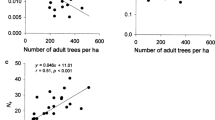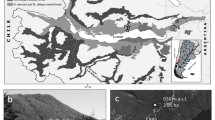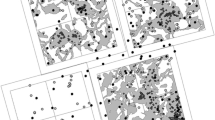Abstract
Impacts of forest harvesting and regeneration practices on genetic diversity in the Australian native forest species Eucalyptus consideniana Maiden (yertchuk) were examined using 29 Mendelian DNA markers (18 RFLPs and 11 microsatellites). Two replicate logging coupes were studied from each of the two most commonly employed silvicultural treatments: clear felling with aerial re-sowing and the seed tree system. For each coupe, genetic diversity measures were compared between a sample of the sapling regeneration and a corresponding control sample from bordering unharvested trees. When calculations were performed over all 29 loci, significant reductions of allelic richness (AR), effective number of alleles (AE) and/or expected heterozygosity (HE) were detected on one or both of seed tree coupes, but on neither of the clear falls. When calculations were performed over the 11 microsatellites alone, all three measures, AR, AE and HE, were significantly reduced on both of the seed replicates but on neither of the two clear falls. In contrast, when the RFLPs were examined separately, there were no significant reductions of diversity on either of the two seed tree coupes or on the two clear falls. These results suggest that genetic erosion is more likely under the seed tree system than under clear-felling with aerial re-sowing and that there is greater statistical power to detect it with microsatellites than with RFLPs. A Monte Carlo simulation to test the statistical significance of the number of apparently lost or gained alleles showed that significant losses of alleles above specified threshold frequencies occurred only in the two seed tree replicates. Three of the four control and regeneration population pairs were significantly differentiated, as indicated by exact tests or by pairwise FST estimates. Comparisons of CONTML dendrograms, constructed for the regeneration populations only versus the control populations only, indicated that genetic drift was significantly promoted under forest management. No significant decreases in observed heterozygosity, or increases in the panmictic index (f), were observed in any of the comparisons suggesting that inbreeding was not promoted by a single rotation of forest management.


Similar content being viewed by others
References
Adams WT, Zuo J, Shimizu JY, Tappeiner JC (1998) Impact of alternative regeneration methods on genetic diversity in coastal Douglas-fir. For Sci 44:390–396
Archie JW (1985) Statistical analysis of heterozygosity data: independent sample comparisons. Evolution 39:623–637
Boland DJ, Brooker MIH, Chippendale GM, Hall N, Hyland BPM, Johnston RD, Kleinig DA, Turner JD (1984) Forest trees of Australia. Nelson Wadsworth and CSIRO, Melbourne
Booy G, Hendriks RJJ, Smulders MJM, van Groenendael JM, Vosman B (2000) Genetic diversity and the survival of populations. Plant Biol 2:379–395
Boyle TJ (2000) Criteria and indicators for the conservation of genetic diversity. In: Young AG, Boshier D, Boyle T (eds) Forest conservation genetics: principles and practice. CAB International, New York, USA
Byrne M, Moran GF, Murrell JC, Tibbits WN (1994) Detection and inheritance of RFLPs in Eucalyptus nitens. Theor Appl Genet 89:397–402
Byrne M, Murrell JC, Allen B, Moran GF (1995) An integrated genetic linkage map for eucalypts using RFLP, RAPD and isozyme markers. Theor Appl Genet 91:869–875
Byrne M, Marquez-Garcia MI, Uren T, Smith DS, Moran GF (1996) Conservation and genetic diversity of microsatellite loci in the genus Eucalyptus. Aust J Bot 44:331–341
Byrne M, Parrish TL, Moran GF (1998) Nuclear RFLP diversity in Eucalyptus nitens. Heredity 81:225–233
Chicurel M (2001) Faster, better, cheaper genotyping. Nature 412:580–582
Commonwealth of Australia (1992) National forest policy statement: a new focus for Australia's forests. Commonwealth of Australia, Canberra
Cremer KW (1977) Distance of seed dispersal in eucalypts estimated from seed weights. Aust For Res 7:225–228
El-Kassaby YA (2000) Impacts of industrial forestry on genetic diversity of temperate forest trees. In: Mátyás C (ed) Forest genetics and sustainability. Kluwer Academic Publishers, The Netherlands, pp 155–169
Felsenstein J (1981) Evolutionary trees from gene frequencies and quantitative characters: finding maximum likelihood estimates. Evolution 35:1229–1242
Felsenstein J (1993) PHYLIP (Phylogeny Inference Package) version 3.5c. Department of Genetics, University of Washington, Seattle, USA, http://evolution.genetics.washington.edu/phylip.html
Gillies ACM, Navarro C, Lowe AJ, Newton AC, Hernández M, Wilson J, Cornelius JP (1999) Genetic diversity in Mesoamerican populations of mahogany (Swietenia macrophylla), assessed using RAPDs. Heredity 83:722–732
Glaubitz JC, Emebiri LC, Moran GF (2001) Dinucleotide microsatellites from Eucalyptus sieberi: inheritance, diversity and improved scoring of single-base differences. Genome 44:1041–1045
Glaubitz JC, Wu HX, Moran GF (2003) Impacts of silviculture on genetic diversity in the native forest species Eucalyptus sieberi. Conserv Genet (in press)
Gömöry D (1992) Effect of stand origin on the genetic diversity of Norway spruce (Picea abies Karst.) populations. For Ecol Management 54:215–223
Goudet J, Raymond M, de Meeüs T, Rousset F (1996) Testing differentiation in diploid populations. Genetics 144:1933–1940
Kimura M, Crow J (1964) The number of alleles that can be maintained in a finite population. Genetics 49:725–738
Knowles P (1985) Comparison of isozyme variation among natural stands and plantations: jack pine and black spruce. Can J For Res 15:902–908
Lee CT, Wickneswari R, Mahani MC, Zakri AH (2002) Effect of selective logging on the genetic diversity of Scaphium macropodum. Biol Conservation 104:107–118
Lewis PO, Zaykin D (2000) Genetic data analysis: computer program for the analysis of allelic data. Version 1.0 (d15). Free program distributed by the authors over the internet from the GDA Home Page at http://lewis.eeb.uconn.edu/lewishome/gda.html
Lutze M (1998) Species composition in mixed species regeneration following a range of harvesting and site preparation treatments in a lowland eucalypt forest in East Gippsland. VSP Technical Report No. 33, Department of Natural Resources and Environment, Victoria, Australia
Macdonald SE, Thomas BR, Cherniawsky DM, Purdy BG (2001) Managing genetic resources of lodgepole pine in west-central Alberta: patterns of isozyme variation in natural populations and effects of forest management. For Ecol Management 152:45–58
Manly BFJ (1997) Randomization, bootstrap and Monte Carlo methods in biology. Chapman and Hall, London
Montréal Process Working Group (1999) Criteria and indicators for the conservation and sustainable management of temperate and boreal forests, 2nd edn. The Montréal Process, http://www.mpci.org/meetings/ci/ci_e.html
Neale DB (1985) Genetic implications of shelterwood regeneration of Douglas-fir in Southwest Oregon. For Sci 31:995–1005
Newman D, Pilson D (1997) Increased probability of extinction due to decreased genetic effective population size: experimental populations of Clarkia pulchella. Evolution 51:354–362
Perry DJ, Bousquet J (2001) Genetic diversity and mating system of post-fire and post-harvest black spruce: an investigation using codominant sequence-tagged-site (STS) markers. Can J For Res 31:32–40
Rajora OP (1999) Genetic biodiversity impacts of silvicultural practices and phenotypic selection in white spruce. Theor Appl Genet 99:954–961
Raymond M, Rousset F (1995a) GENEPOP (version 1.2): population genetics software for exact tests and ecumenicism. J Hered 86:248–249 (version 3.3 can be downloaded from ftp://ftp.cefe.cnrs-mop.fr/genepop/)
Raymond M, Rousset F (1995b) An exact test for population differentiation. Evolution 49:1280–1283
Stoehr MU, El-Kassaby YA (1997) Levels of genetic diversity at different stages of the domestication cycle of interior spruce in British Columbia. Theor Appl Genet 94:83–90
Thamarus KA, Groom K, Murrell J, Byrne M, Moran GF (2002) A genetic linkage map for Eucalyptus globulus with candidate loci for wood, fibre and floral traits. Theor Appl Genet 104:379–387
Thomas BR, Macdonald SE, Hicks M, Adams DL, Hodgetts RB (1999) Effects of reforestation methods on genetic diversity of lodgepole pine: an assessment using microsatellite markers and randomly amplified polymorphic DNA markers. Theor Appl Genet 98:793–801
Wang L (1997) The soil seed bank and understorey regeneration in Eucalyptus regnans forest, Victoria. Aust J Ecol 22:404–411
Weir BS (1996) Genetic data analysis II: methods for discrete population genetic data. Sinauer Associates, Sunderland, Massachusetts, USA
Weir BS, Cockerham CC (1984) Estimating F-statistics for the analysis of population structure. Evolution 38:1358–1370
Westemeier RL, Brawn JD, Simpson SA, Esker TL, Jansen RW, Walk JW, Kershner EL, Bouzat JL, Paige KN (1998) Tracking the long-term decline and recovery of an isolated population. Science 282:1695–1698
Yeh FC, Yang R-C, Boyle TBJ, Ye Z-H, Mao JX (1997) POPGENE, the user-friendly shareware for population genetic analysis. Molecular Biology and Biotechnology Centre, University of Alberta, Canada. http://www.ualberta.ca/∼fyeh/index.htm
Young AG, Boshier D, Boyle T (2000) Forest conservation genetics: principles and practice. CAB International, New York, USA
Acknowledgements
We thank John Lamour and Peter Perry for assistance with field sampling, Hiroko Glaubitz and Josephine Morosin for assistance with DNA extraction, the Victoria Department of Natural Resources and Environment (Mark Lutze, Maureen Murray and Peter Geary in particular) for access to the study site, information and advice, and Karen Fullard, Charlie Bell, Yong-Bi Fu, and two anonymous reviewers, for helpful suggestions on the original manuscript. We gratefully acknowledge financial support received from the Forest and Wood Products Research and Development Corporation of Australia.
Author information
Authors and Affiliations
Corresponding author
Additional information
Communicated by D.B. Neale
Rights and permissions
About this article
Cite this article
Glaubitz, J.C., Murrell, J.C. & Moran, G.F. Effects of native forest regeneration practices on genetic diversity in Eucalyptus consideniana. Theor Appl Genet 107, 422–431 (2003). https://doi.org/10.1007/s00122-003-1262-8
Received:
Accepted:
Published:
Issue Date:
DOI: https://doi.org/10.1007/s00122-003-1262-8




